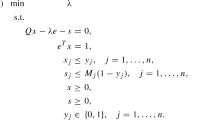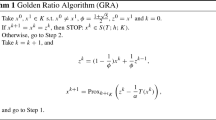Abstract
We attempt to motivate and survey recent research on the use of “strong” valid inequalities and reformulation to solve mixed integer programming problems.
Similar content being viewed by others
References
P. Afentakis, B. Gavish and U. Karmarkar, “Computationally efficient optimal solutions to the lot-sizing problem in multistage assembly systems,”Management Science 30 (1984) 222–239.
E. Balas, “Disjunctive programming,”Annals of Discrete Mathematics 5 (1979) 3–51.
E. Balas, “On the facial structure of scheduling polyhedra,”Mathematical Programming Study 24 (1985) 179–218.
E. Balas and W.R. Pulleyblank, “The perfectly matchable subgraph polytope of a bipartite graph,”Networks 13 (1983) 486–516.
I. Barany, T.J. Van Roy and L.A. Wolsey, “Strong formulations for multi item capacitated lot-sizing,”Management Science (1984) 1255–1271.
I. Barany, T.J. Van Roy and L.A. Wolsey, “Uncapacitated lot-sizing: The convex hull of solutions,”Mathematical Programming Study 22 (1984) 32–43.
J.F. Benders, “Partitioning procedures for solving mixed variables programming problems,”Numerische Mathematik 4 (1962) 238–252.
H.P. Crowder, E.L. Johnson and M.W. Padberg, “Solving large-scale zero–one linear programming problems,”Operations Research 31 (1983) 803–834.
H.P. Crowder and M.W. Padberg, “Solving large-scale symmetric traveling salesman problems to optimality,”Management Science 26 (1980) 495–509.
G.D. Eppen and R.K. Martin, “Solving multi-item capacitated lot-sizing problems using variable redefinition,” Working Paper, Graduate School of Business, University of Chicago (Chicago, IL, 1985).
M. Florian and M. Klein, “Deterministic production planning with concave costs and capacities constraints,”Management Science 18 (1971) 12–20.
M. Goemans, “Génération dynamique d'inégalités valables pour des problèmes de planification de la production comprenant des temps de lancement,” Engineer's Thesis, Université Catholique de Louvain (Louvain-la-Neuve, June 1987).
M. Grötschel, “On the symmetric travelling salesman problem: Solution of a 120-city problem,”Mathematical Programming Study 12 (1980) 61–77.
M. Grötschel, M. Junger and G. Reinelt, “A cutting plane algorithm for the linear ordering problem,”Operations Research 32 (1984) 1195–1220.
M. Grötschel, L. Lovasz and A. Schrijver, “The ellipsoid method and its consequences theorems in combinatorial optimization,”Combinatorica 1 (1981) 169–197.
K.L. Hoffman and M.W. Padberg, “LP-based combinatorial problem solving,”Annals of Operations Research 4 (1985) 145–194.
IBM, “Pure integer programming executor,” Program Description and Operations Manual, SB11–5712-0, File Number S370-82, IBM The Netherlands (1982).
R.G. Jeroslow, “Representability in mixed integer programming 11: A lattice of relaxations,” College of Management, Georgia Institute of Technology (Atlanta, GA, 1985).
R.G. Jeroslow and J.K. Lowe, “Modelling with integer variables,”Mathematical Programming Study 22 (1984) 167–184.
J. Krarup and O. Bilde, “Plant location, set covering, and economic lot-size: An O(mn) algorithm for structured problems,” in:Numerische Methoden bei Optimierungsaufgaben, Band 3: Optimierung bei Graphentheoretischen und Ganz-zahlligen Problemen (Birkhauser, Basel-Stuttgart, 1977).
K.M.Y. Leung and T.L. Magnanti, “Valid inequalities and facets of the capacitated plant location problem,” Report OR 149-86, Operations Research Center, MIT (Cambridge, MA, 1986).
Lindo, The Scientific Press, Palo Alto.
T.L. Magnanti, “Linear programming and fixed charge network flow problems,” presented at the Symposium: Research and Decision Making in Economics, Management and Engineering, January 1987, CORE, Université Catholique de Louvain (Louvain-la-Neuve, 1987).
R.E. Marsten, “XMP: A structured library of subroutines for experimental mathematical programming,”ACM Transactions of Mathematical Software 7 (1981) 481–497.
R.K. Martin, “Using separation algorithms to generate mixed integer model reformulations,” Graduate School of Business, University of Chicago (Chicago, IL, 1987).
R.K. Martin, R.L. Rardin and B.A. Campbell, “Polyhedral characterization of discrete dynamic programming,” CC-87–24 Institute for Interdisciplinary Engineering Studies, Purdue University (1987).
R.K. Martin and L. Schrage, “Subset coefficient reduction,”Operations Research 33 (1985) 505–526.
W. Maxwell, private communication, Cornell University (1985).
M.W. Padberg, T.J. Van Roy and L.A. Wolsey, “Valid linear inequalities for fixed charge problems,”Operations Research 33 (1985) 842–861.
Y. Pochet, “Valid inequalities and separation for capacitated economic lot sizing,”Operations Research Letters 7 (1988) 109–115.
Y. Pochet and L.A. Wolsey, “Lot-size models with backlogging: Strong reformulations and cutting planes,”Mathematical Programming 40 (1988) 317–335.
SCICONIC, VM User Guide, Scicon Computer Services Ltd, Milton Keynes (1981).
T.J. Van Roy and L.A. Wolsey, “Valid inequalities and separation for uncapacitated fixed cost networks,”Operations Research Letters 4 (1985) 105–112.
T.J. Van Roy and L.A. Wolsey, “Valid inequalities for mixed 0–1 programs,”Discrete Applied Mathematics 14 (1986) 199–213.
T.J. Van Roy and L.A. Wolsey, “Solving mixed 0–1 programs by automatic reformulation,”Operations Research 35 (1987) 45–57.
W.I. Zangwill, “A deterministic multi-period production scheduling model with backlogging,”Management Science 13 (1966) 105–119.
Author information
Authors and Affiliations
Rights and permissions
About this article
Cite this article
Wolsey, L. Strong formulations for mixed integer programming: A survey. Mathematical Programming 45, 173–191 (1989). https://doi.org/10.1007/BF01589102
Received:
Revised:
Issue Date:
DOI: https://doi.org/10.1007/BF01589102




